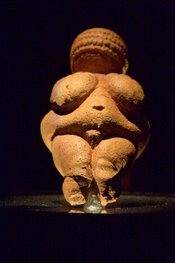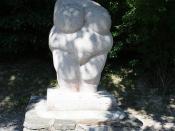Compare and Contrast: Venus of Willendorf vs. Cycladic figures
What is the difference between two figures that both represent the same basic idea? Give up? Well don't worry, by the time you are done reading this paper you will be fully versed in the answer to this interesting and quite debated question.
Venus of Willendorf "was found on August 7th, 1908 during a systematic excavation in the ninth and highest layer of Site II in Willendorf, Austria by Josef Szombathy. The most recent estimate of her date of origin is 24,000-22,000 B.C " (Chapman, 1998, p.1). She is one of the most famous of the non-tool artifacts created by the earlier Stone Age people. It was said that the "earlier Stone Age people were content to collect pebbles in whose natural shape they saw something that made them special " (Janson, 2001, p.35). As written by Janson, (2001) apparently the Willendorf 's voluptuous figure was formed by an egg shaped pebble.
Her shape definitely gives off a womanly aura which is probably why she is considered a symbol of fertility. According to Hahn, Joachim, (1996) other hints that gave way to the belief of her being a fertility Goddess was the red ochre pigment in which she was painted with after being carved from oolitic limestone which could possibly represent blood, a life giving agent. Whether or not this is true her very being gives reason to believe that ancient civilizations had some kind of religion.
Cycladic figures as told by Janson (2001) represented a highly developed phase in time around 2500-2400B.C. They were created in the Cycladic Islands which are located in the southern Aegean sea. These marble figures must have also had a religious meaning to them because they were buried with the dead. These impressive figures were...



Pretty good
There were several good points, but you could have made it a little more cohesive. Good luck next time
0 out of 0 people found this comment useful.